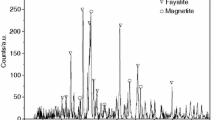Abstract
The presented paper presents the results of laboratory tests aimed at verifying the suitability for use as a biomass reducing agent in the form of sunflower pellets for the reduction of nonferrous metal oxides. A number of research techniques were used to verify the behavior of the tested material in the reduction process. The techniques used are mainly based on the use of high temperature, which is characteristic of metallurgical processes. The obtained results indicate that this material has similar values to other raw materials of this type in terms of heat of combustion at the level of 16 to 19 MJ kg−1 and the content of volatile components at the level of 75 pct by mass. Research on the reduction of copper slags using sunflower pellets was carried out in various variants of duration and the amount of reducing agent added. The temperature of 1300 °C adopted in the tests reflects the actual process conditions. The obtained results indicate that with the increase in the amount of reducing agent added from 5.67 up to 12.0 wt pct, the degree of transition of copper and lead to the metallic phase increases from approximately 24 to 56 pct.






Source Reprinted from Ref. [32] under CC 4.0 License

Source Reprinted from Ref. [32] under CC 4.0 License




Similar content being viewed by others
References
M. Półka and S. Ptak: Procedia Eng., 2017, vol. 192, pp. 743–47.
Md. Obaidullah, S. Bram, V.K. Verma, and J. De Ruyck: Int. J. Renew. Energy Res., 2012, vol. 2, pp. 147–59.
M.M. Roy and K.W. Corscadden: Appl. Energy, 2012, vol. 99, pp. 206–212.
H. Radomiak, A. Bala-Litwiniak, M. Zajemska, and D. Musiał: E3S Web Conf., https://doi.org/10.1051/e3sconf/20171402043.
J.R. Vyvyan: Tetrahedron, 2002, vol. 58, pp. 1631–46.
N. Quaranta, M. Unsen, H. López, C. Giansiracusa, J.A. Roether, and A.R. Boccaccini: Ceram. Int., 2011, vol. 37, pp. 377–85.
M. Barczewski, K. Sałasińska, and J. Szulc: Polym. Test., 2019, vol. 75, pp. 1–11.
M. Kułażyński, S. Jabłoński, J. Kaczmarczyk, Ł Świątek, K. Pstrowska, and M. Łukaszewicz: J. Energy Inst., 2018, vol. 91, pp. 668–75.
A. Bala-Litwiniak and M. Zajemska: Renew. Energ., 2020, vol. 162, pp. 151–59.
R.J. García López, C. Hernández Fernández, J.M. Fierro, J. Cara, O.S. Martinez, and M. Sánchez: Energy, 2014, vol. 74, pp. 845–54.
H. Zhang, G. Zhu, H. Yan, T. Li, and Y. Zhao: Metall. Mater. Trans. B, 2013, vol. 44B, pp. 889–96.
U. Kumar, S. Maroufi, R. Rajarao, M. Mayyas, I. Mansuri, R.K. Joshi, and V. Sahajwalla: J. Clean. Prod., 2017, vol. 158, pp. 218–24.
Z. Zuo, Q. Yu, M. Wei, H. Xie, W. Duan, K. Wang, and Q. Qin: J. Therm. Anal. Calorim., 2016, vol. 126, pp. 481–91.
S. Zhou, Y. Wei, S. Zhang, B. Li, H. Wang, Y. Yang, and M. Barati: J. Clean. Prod., 2019, vol. 236, 117668.
Z. Zuo, Q. Yu, H. Xie, Q. Qin, and M. Wei: Energy Technol., 2018, https://doi.org/10.1007/978-3-319-72362-4_6.
Z. Zuo, Q. Yu, S. Luo, J.-K. Zhang, and E. Zhou: Energy Fuels, 2020, vol. 34, pp. 491–500.
G. Qu, Y. Wei, B. Li, H. Wang, Y. Yang, and A. McLean: in 11th International Symposium on High-Temperature Metallurgical Processing, Z. Peng, J.-Y. Hwang, J.P. Downey, D. Gregurek, B. Zhao, O. Yücel, E. Keskinkilic, T. Jiang, J.F. White, and M.M. Mahmoud, eds., Springer, Cham, 2020, pp. 417–29.
B. Li, Y. Wei, H. Wang, and Y. Yang: ISIJ Int., 2018, vol. 58, pp. 1168–74.
J. Łabaj, L. Blacha, M. Jodkowski, A. Smalcerz, M. Fröhlichová, and R. Findorák: J. Clean. Prod., 2021, vol. 288, p. 125640.
L. Blacha, J. Łabaj, M. Jodkowski, and A. Smalcerz: Metalurgija, 2020, vol. 59, pp. 329–32.
T.C. Ooi, E. Aries, B.C.R. Ewan, D. Thompson, D.R. Anderson, R. Fisher, T. Fray, and D. Tognarelli: Miner. Eng., 2008, vol. 21, pp. 167–77.
N. Kantová, A. Čaja, P. Belany, Z. Kolková, P. Hrabovský, D. Hečko, and P. Mičko: Bioresources, 2022, vol. 17, pp. 1881–91.
M.N. Mami, M. Lajili, B. Khiari, and M. Jeguirim: Fuel, 2020, vol. 277, pp. 118181–91.
A. Forero, J. Jochum, and S. Vargas: Environmental Biotechnology, 2012, vol. 8(2), pp. 67–76.
N. Hussain, N. Feroze, M.A. Kazmi, and M. Iqbal: Sci. Int., 2016, vol. 25, pp. 4547–56.
Chemistry Software Suite: http://www.hsc-chemistry.net/, accessed 15 Jan 2023.
A. Bala-Litwiniak: Gospodarka Materiałowa i Logistyka, 2019, vol. 2019, pp. 49–54.
F. Duan, J. Zhang, C.-S. Chyang, Y. Wang, and J. Tso: Fuel Process. Technol., 2014, vol. 128, pp. 28–35.
J.M. Ebeling and B.M. Jenkins: Trans. ASABE, 1985, vol. 28, pp. 898–902.
A. Demirbaş: Fuel, 1997, vol. 76, pp. 431–34.
C. Sheng and J.L.T. Azevedo: Biomass Bioenergy, 2005, vol. 28, pp. 499–507.
S. Ptak and M. Półka: Wpływ Biomasy Na Parametry Palności I Wybuchowości Pyłu Węgla Kamiennego, Szkoła Główna Służby Pożarniczej, Warsaw, Poland, 2018.
Acknowledgments
The authors declare that they have no conflict of interest.
Author information
Authors and Affiliations
Contributions
Szymon Ptak: Conceptualization, investigation, and writing—original draft; Tomasz Matuła: formal analysis and investigation; Leszek Blacha: writing—review and editing, writing—original draft, and supervision; Jerzy Łabaj: methodology and resources; Albert Smalcerz: conceptualization, formal analysis, and supervision; Marzena Półka: methodology, investigation, and supervision
Corresponding author
Additional information
Publisher's Note
Springer Nature remains neutral with regard to jurisdictional claims in published maps and institutional affiliations.
Rights and permissions
Springer Nature or its licensor (e.g. a society or other partner) holds exclusive rights to this article under a publishing agreement with the author(s) or other rightsholder(s); author self-archiving of the accepted manuscript version of this article is solely governed by the terms of such publishing agreement and applicable law.
About this article
Cite this article
Ptak, S., Matuła, T., Blacha, L. et al. Reduction of Metallurgical Slags Using Sunflower Pellets. Metall Mater Trans B (2024). https://doi.org/10.1007/s11663-024-03059-5
Received:
Accepted:
Published:
DOI: https://doi.org/10.1007/s11663-024-03059-5




